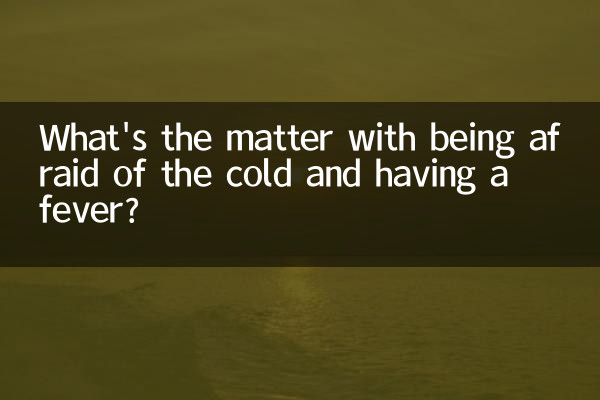What's the matter with being afraid of the cold and having a fever?
Recently, with the changes in temperature and the arrival of the flu season, "fever due to cold" has become a hotly discussed health topic across the Internet. Many netizens shared their symptoms on social platforms, and related searches increased by more than 200% in 10 days. This article will combine the latest data and medical knowledge to explain the reasons behind this common symptom and how to deal with it.
1. Network-wide popularity data statistics (last 10 days)

| platform | Amount of related topics | Hot search highest ranking | Main focus of discussion |
|---|---|---|---|
| 187,000 items | No. 3 | Identifying Flu Symptoms | |
| Douyin | 230 million views | No. 1 on the health list | Physical cooling method |
| Zhihu | 647 questions | Science hot list | Pathological mechanism analysis |
| Baidu | Average daily search volume: 120,000 | Medical TOP5 | Medication Guide |
2. Physiological mechanism of cold and fever
When the thermoregulatory center (hypothalamus) adjusts the set point higher, the following typical responses occur:
| stage | Physiological reaction | duration |
|---|---|---|
| chill period | Muscle tremors produce heat and pores shrink | 30-60 minutes |
| high fever period | Red skin and rapid breathing | hours |
| Antipyretic period | Profuse sweating, body temperature drops | 2-4 hours |
3. Analysis of causes of recent high incidence rates
According to outpatient data from tertiary hospitals (December statistics), the main causes of cold sensitivity and fever are distributed as follows:
| Cause type | Proportion | Typical characteristics |
|---|---|---|
| influenza virus | 42% | Sudden high fever and body aches |
| common cold | 28% | Mainly low-grade fever and nasal congestion |
| bacterial infection | 18% | Persistent high fever and local inflammation |
| Others | 12% | Professional diagnosis required |
4. Key points of home care
1.Body temperature monitoring:It is recommended to use an electronic thermometer and measure it every 4 hours. Drug intervention is required if the temperature exceeds 38.5℃.
2.Physical cooling:Use warm water at 32-34℃ to wipe the neck, armpits and other large blood vessels. Avoid using alcohol (it may cause chills)
3.Medication options:Acetaminophen (preferred for children) or ibuprofen, avoid aspirin in children
4.Nutritional supplements:The daily amount of drinking water should reach 2000ml, and an appropriate amount of vitamin C can be supplemented (not more than 500mg daily)
5. Medical warning signs
You should seek medical attention immediately if the following conditions occur: persistent high fever for more than 3 days, confusion, rash with fever, convulsions, difficulty breathing, etc. Special reminder: Infants and young children whose body temperature exceeds 39°C and who are listless require emergency treatment.
6. Suggestions on preventive measures
1. Get the flu vaccine (the best time is October-November)
2. Wear a mask in public places (the influenza positivity rate has recently increased to 25.7%)
3. Maintain 30 minutes of moderate-intensity exercise every day
4. Control indoor humidity at 40-60%
Cold waves have been frequent recently. We remind everyone to pay attention to keeping warm. If symptoms of cold sensitivity and fever occur, it is recommended to observe at home for 24 hours to avoid cross infection. Only by mastering correct health knowledge can we better cope with the high incidence of seasonal diseases.

check the details

check the details